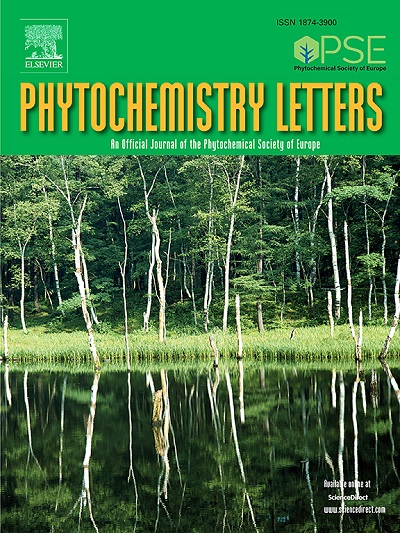Polycyclic polyprenylated acylphloroglucinols with cytotoxicity against human tongue squamous carcinoma cells in vitro from Hypericum curvisepalum
IF 1.4
4区 生物学
Q4 CHEMISTRY, MEDICINAL
引用次数: 0
Abstract
From the entire plant of Hypericum curvisepalum, two previously undescribed polycyclic polyprenylated acylphloroglucinols (1–2) and eleven structurally analogous compounds (3–13) were successfully isolated. The structural elucidation of these compounds was accomplished through a comprehensive approach, integrating extensive spectroscopic data analyses with [Mo₂(OAc)₄]- and [Rh₂(OCOCF₃)₄]-induced electronic circular dichroism experiments. Subsequently, the in vitro cytotoxic activities of the isolated compounds were evaluated against three distinct strains of tongue carcinoma cells. Among them, compounds 2 and 3 displayed moderate cytotoxic effects. Notably, compound 1 demonstrated potent activity against Cal-27 cells, with an IC₅₀ value of 18.55 ± 0.93 μM. Further investigations revealed that the cytotoxicity of compound 1 was closely associated with the promotion of ROS-mediated apoptosis and the inhibition of the S phase in the cell cycle.
多环聚戊烯酰化酰基间苯三酚体外抗人舌鳞癌细胞毒性研究
从双曲金丝桃(Hypericum curvisepalum)整个植物中,成功分离出2个先前未被描述的多环聚戊烯酰化酰基间苯三酚(1-2)和11个结构类似的化合物(3-13)。这些化合物的结构解析是通过综合的方法完成的,将广泛的光谱数据分析与[Mo₂(OAc)₄]-和[Rh₂(OCOCF₃)₄]-诱导的电子圆二色性实验相结合。随后,对分离得到的化合物对三种不同的舌癌细胞进行了体外细胞毒活性评价。其中化合物2和3表现出中等的细胞毒作用。值得注意的是,化合物1显示出对Cal-27细胞的有效活性,IC₅₀值为18.55 ± 0.93 μM。进一步研究发现,化合物1的细胞毒性与促进ros介导的细胞凋亡和抑制细胞周期S期密切相关。
本文章由计算机程序翻译,如有差异,请以英文原文为准。
求助全文
约1分钟内获得全文
求助全文
来源期刊

Phytochemistry Letters
生物-生化与分子生物学
CiteScore
3.00
自引率
11.80%
发文量
190
审稿时长
34 days
期刊介绍:
Phytochemistry Letters invites rapid communications on all aspects of natural product research including:
• Structural elucidation of natural products
• Analytical evaluation of herbal medicines
• Clinical efficacy, safety and pharmacovigilance of herbal medicines
• Natural product biosynthesis
• Natural product synthesis and chemical modification
• Natural product metabolism
• Chemical ecology
• Biotechnology
• Bioassay-guided isolation
• Pharmacognosy
• Pharmacology of natural products
• Metabolomics
• Ethnobotany and traditional usage
• Genetics of natural products
Manuscripts that detail the isolation of just one new compound are not substantial enough to be sent out of review and are out of scope. Furthermore, where pharmacology has been performed on one new compound to increase the amount of novel data, the pharmacology must be substantial and/or related to the medicinal use of the producing organism.
 求助内容:
求助内容: 应助结果提醒方式:
应助结果提醒方式:


